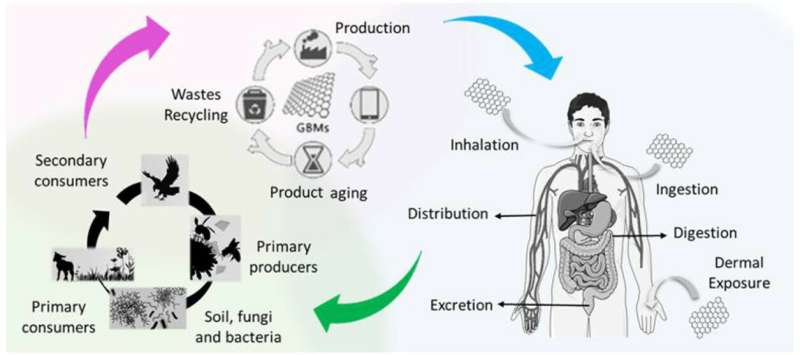Graphene Flagship researchers reviewed the current research into the safety of graphene and related materials Credit: Fotolia / Graphene Flagship
As the drive to commercialise graphene continues, it is important that all safety aspects are thoroughly researched and understood. The Graphene Flagship project studies the impact of graphene and related materials on human health, as well as its environmental impact. This enables safety by design to become a core part of innovation.
Researchers and companies are currently using a range of materials such as layered graphene, graphene oxide and heterostructures. The first step to assess graphene toxicology is to fully characterise these materials. This work overviews the production and characterisation methods of new materials, and considers which biological effects depend on their inherent properties.
"One of the key messages is that this family of materials has varying properties, thus displaying varying biological effects. It is important to emphasize the need not only for a systematic analysis of well-characterized graphene-based materials, but also the importance of using standardised in vitro or in vivo assays for the safety assessment," says Bengt Fadeel, lead author of this paper working at Graphene Flagship partner Karolinska Institutet, Sweden.
"This review correlates the physico-chemical characteristics of graphene and related materials to biological effects. A classification based on lateral dimensions, number of layers and carbon-to-oxygen ratio allows us to describe the parameters that can alter graphene's toxicology. This can orient future development and use of these materials," explains Alberto Bianco from Graphene Flagship partner CNRS, France, and deputy leader of the Graphene Flagship Work Package on Health and Environment.
Illustration of the life cycle of graphene-based materials Credit: CC-BY The American Chemical Society
The paper gives a comprehensive overview of all aspects of graphene health and environmental impact, focusing on the potential interactions of graphene-based materials with key target organs including immune system, skin, lungs, cardiovascular system, gastrointestinal system, central nervous system, reproductive system, as well as a wide range of other organisms including bacteria, algae, plants, invertebrates, and vertebrates in various ecosystems.
"One cannot draw conclusions from previous work on other carbon-based materials such as carbon nanotubes and extrapolate to graphene. Graphene-based materials are less cytotoxic when compared to carbon nanotubes, and graphene oxide is readily degradable by cells of the immune system," comments Fadeel.
Andrea C. Ferrari, Science and Technology Officer of the Graphene Flagship and Chair of its Management Panel said, "Understanding any potential health and environmental impacts of graphene and related materials has been at the core of all Graphene Flagship activities since day one. This review provides a solid guide for the safe use of these materials, a key step towards their widespread utilization as targeted by our innovation and technology roadmap."
More information: Bengt Fadeel et al, Safety Assessment of Graphene-Based Materials: Focus on Human Health and the Environment, ACS Nano (2018). DOI: 10.1021/acsnano.8b04758
Journal information: ACS Nano
Provided by Graphene Flagship
























